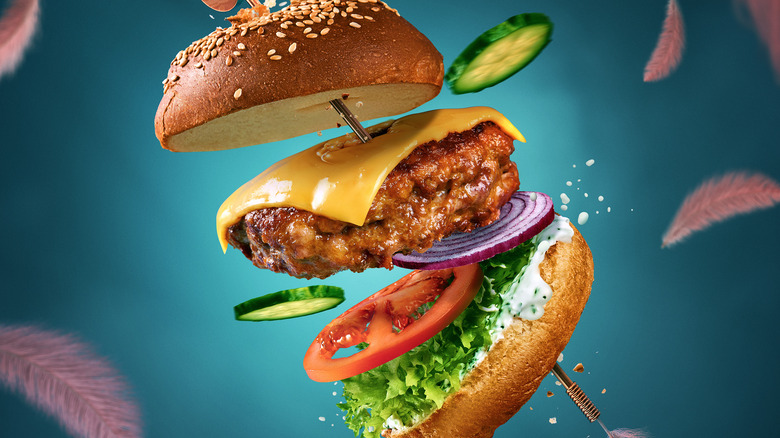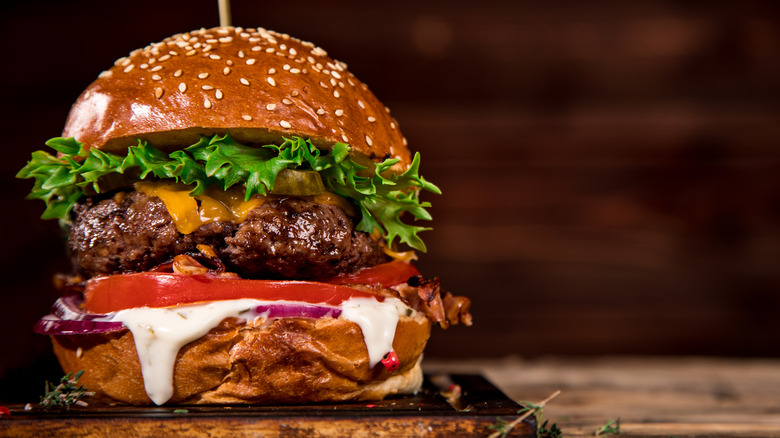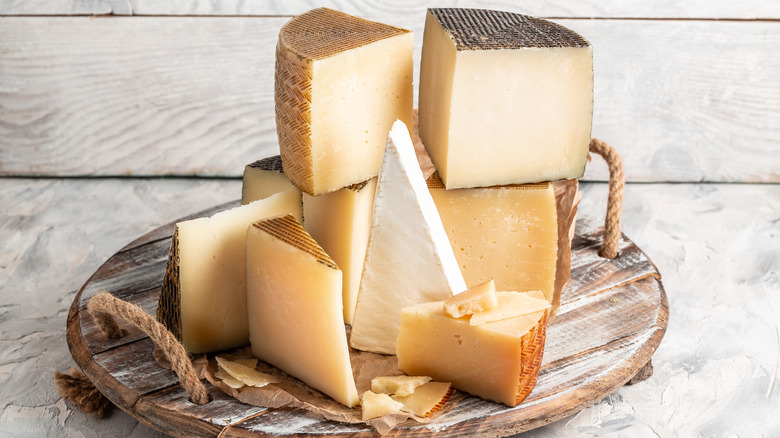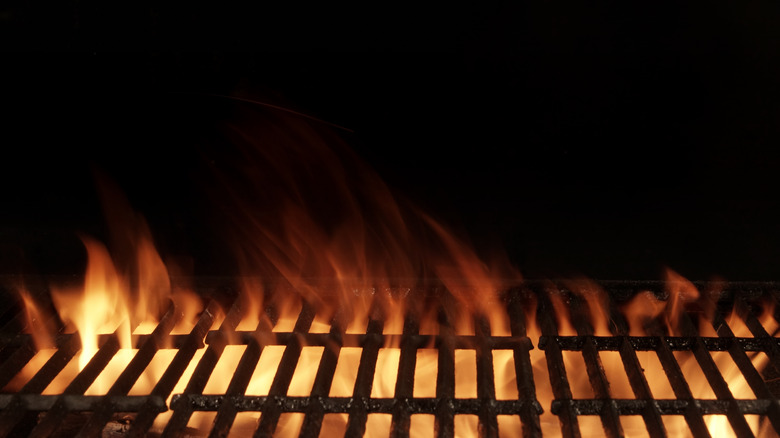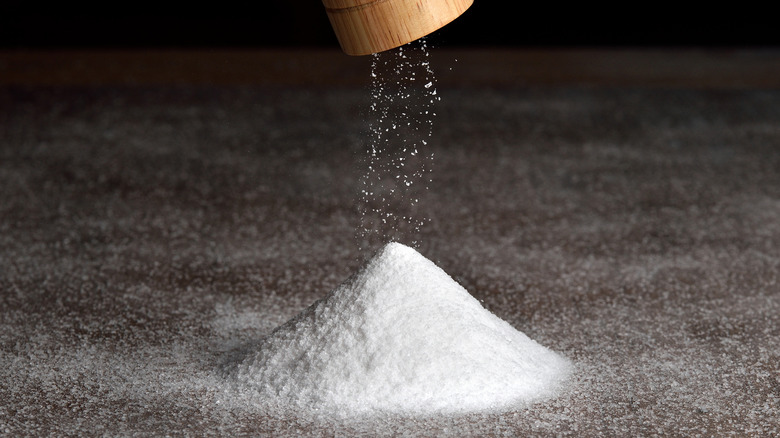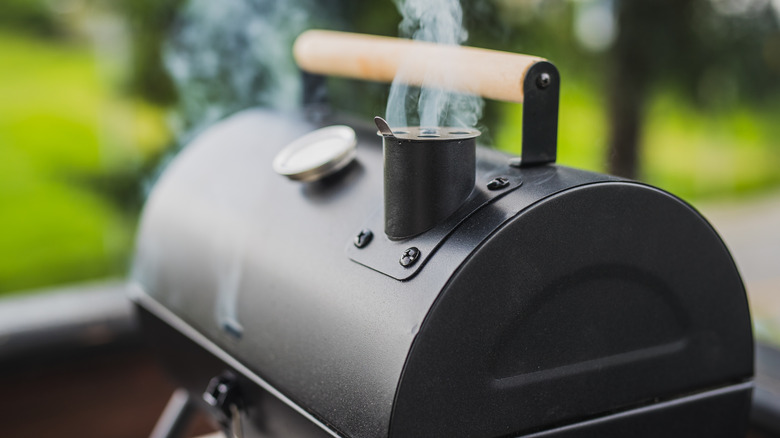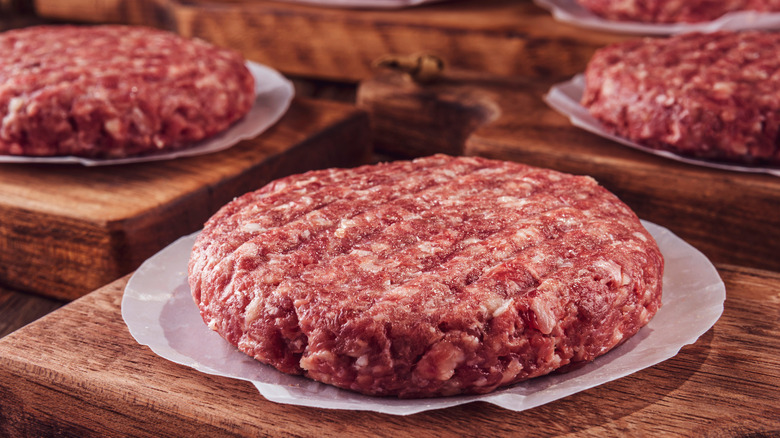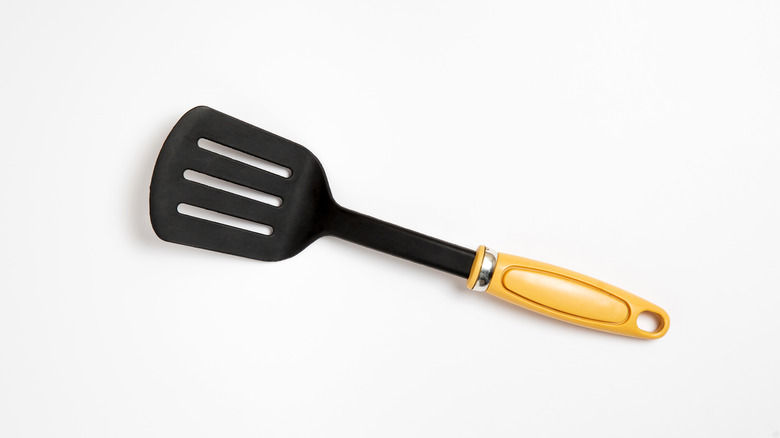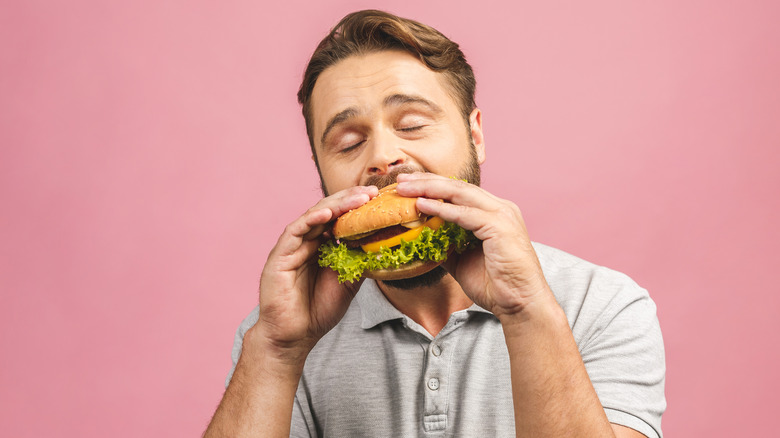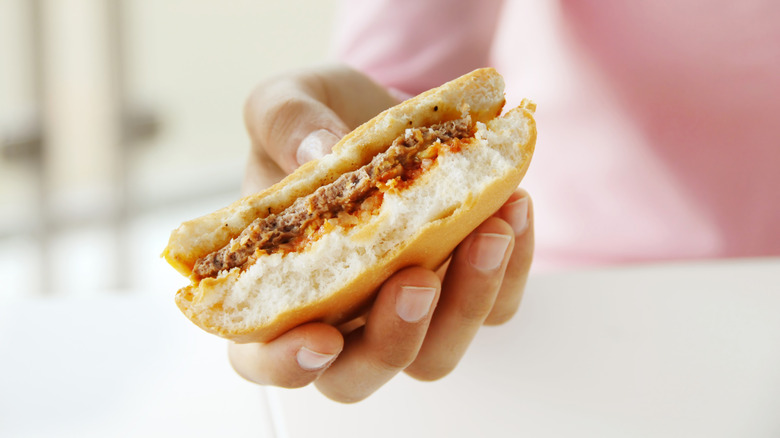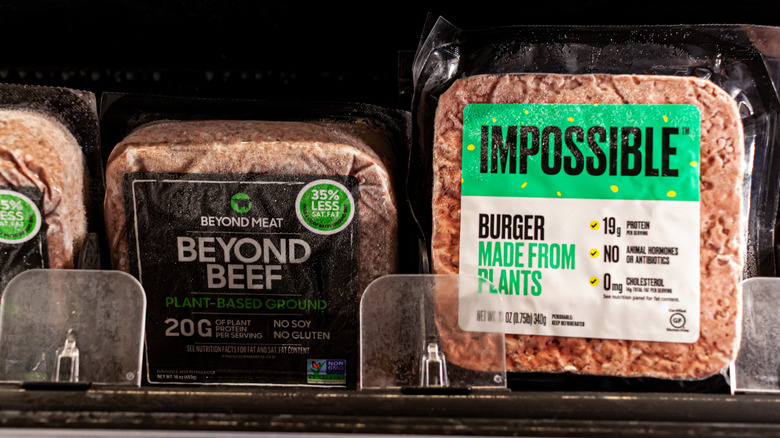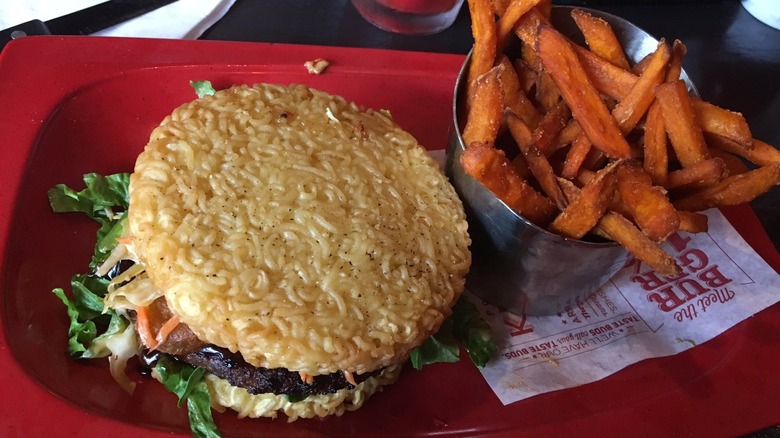Burger Myths You Probably Believe
It's safe to say that burgers inspire passionate debates between cooks. Everybody thinks they make the greatest burger ever, even though it's easy for people to screw up burgers at home. Generations of backyard cooks and food publications have spread recommendations for burger cooking that, upon further investigation, are proven to be flat-out wrong. All told, there's a mountain of confusing, often contradictory advice out there that makes it hard for the average home cook to sort out the good advice from misleading fiction. In a world awash with burger myths, we require the services of some burger Mythbusters.
Fortunately for us, brave souls have dared to challenge burger orthodoxy in order to debunk long-standing burger myths. With their guidance and the right recipes, anyone can make the best-tasting burgers they've ever had. It's time to set the record straight on burger lore. Prepare to forget everything you thought you knew about the humble hamburger. From faulty cooking techniques to specious science to questionable history, we will explore the biggest burger myths you probably believe and let you in on the real facts.
Bigger is always better
Imagine this scene: you go to a fancy steakhouse for dinner and decide to get the burger. What does that burger look like when it shows up at your table? It's probably an enormous patty, eight ounces at least, cooked medium-rare on a grill and delicately balanced on a golden brioche bun. It looks amazing!
Then, you pick it up and realize it's way too tall to fit in your mouth. You awkwardly take a bite that's 90% bread and watch half the patty slide out the back of the sandwich, covering your fingers in grease. You give up and eat the rest with a fork and knife.
A huge steakhouse-style burger is a fun indulgence every once in a while, but there's no denying that the supersized patty throws everything out of whack. As Cup of Jo notes, thick burgers are tough to eat, which is a big issue for a food that's designed to be handheld. Lifehacker further argues that a burger isn't all about the beef, but instead works best when the meat patty harmonizes with toppings, condiments, and bun to create something greater than the sum of its parts. After all, if the beef patty was the main draw of a hamburger, we would all be eating them plain. A thin patty allows for a multifaceted taste experience, with no one component of the sandwich dominating another. Thin burgers don't fall apart into a soggy mess when you eat them, either.
You should use nice cheese
Another thing you see at so-called "fancy" burger places is burgers topped with expensive cheese. Now, we agree that fine imported cheeses are wonderful on a cheese board where they can be appreciated all on their own, but using them on a burger is oftentimes a waste. Not only do pungent cheeses disturb the delicate balance of flavors in a well-crafted burger, but they can lack the gooey, smooth, melty texture of an old-fashioned slice of American cheese. Even highbrow publications like Food & Wine can't argue with the fact that American cheese does something special when melted on a juicy burger.
The truth is that the cheapest American cheese (which, yes, we know is not technically cheese) available in your grocery store might make a better burger than the more expensive, name-brand varieties. In fact, Serious Eats named a generic brand of American cheese as the one that's best suited for burgers. The test also concluded that American cheese product, which has so little cheese that it can't legally be labeled as cheese, performed better than competitors that contained 100% cheese. Likewise, expensive organic brands fell to the bottom of the rankings. It's reassuring to know that sometimes, the cheapest option really is the best one.
The grill gives the best flavor
There's surely no more iconic symbol of summertime than a backyard barbecue, and for many people, that also means throwing some burgers on that grill. Now, if you're a dedicated grillmaster, you can relax. We're not going to argue that grilling is a bad way to cook a burger. Still, we must admit that it has some downsides compared to cooking a burger on a pan or a flattop griddle.
According to Lifehacker, the tastiest part of a burger is the crispy browned crust on the outside, which is a product of the Maillard reaction. Furthermore, Schweid & Sons notes that charcoal grills produce deep browning, but they cook unevenly, leaving some parts of your burger potentially gray and flabby instead of wonderfully charred and crispy. A griddle or cast-iron pan heats more evenly across its entire surface, making it able to brown every inch of your patty.
Another advantage of cooking burgers indoors is that they will likely retain more moisture. Our Modern Kitchen says that a griddle traps the juices that burgers release when cooking. That means there's very little loss of flavor or juiciness during the cooking process. On a grill, however, those juices drip through the grates and vaporize on the coals, which can leave you with a dry, tasteless burger if you're not careful.
Mixing seasonings with the meat ahead of time works
Proper seasoning is the foundation of all good food. And, generally speaking, food tastes the most delicious if every component is well salted. That's why many people mix salt into their burgers before forming patties. Seasoning burgers this way ensures that they are evenly salted all the way through. However, pre-salting ground beef this way comes with a big downside.
Cook's Illustrated tested three techniques for seasoning burgers. In one, they mixed salt throughout the patties. The second batch was left with salt sitting on the exterior of the burgers for half an hour. The third batch wasn't salted until the moment before it hit the grill. The third batch was by far the tastiest of the trio, with the second batch drying out on the outside and the first batch coming out with an unnerving sausage-like texture.
So, what happened? Serious Eats explains that salt denatures the protein in ground meat, changing the texture and making it bind together more tightly. This is desirable in sausages like kielbasa and hot dogs where you want textural cohesion, but it's off-putting in what should be a more loosely-textured burger. This means that, for tender, melt-in-your-mouth burgers, you should wait until the last minute to apply salt.
Hot and fast is the only way to cook a burger
Almost every burger recipe uses basically the same technique to cook burgers. Whether you're grilling, griddling, or pan-searing, the instructions say to get your cooking surface ripping hot so you can get a crust on your burger and cook it in the minimum amount of time possible. But that technique may have more to do with capitalism than good eats. As History notes, burgers took over America in the post-WWII era because of the efforts of fast food chains. It makes sense that these quick-serve franchises would want burgers to cook as quickly as possible because they were trying to serve hungry customers within minutes and make a profit.
At home, where you have the luxury of time, you can take as long to cook your burger as you would like. Smoked burgers from Hey Grill Hey takes over an hour but rewards you with patties that taste more like barbecue brisket than anything you'd get from a drive-through. If you want to think outside the burger box even further, you can try making these steamed burgers from Explore Cook Eat. The recipe replaces the screaming-hot pan with a gentle steam bath, a technique that produces a uniquely moist burger.
There's only one good way to form a burger patty
Many burger myths revolve around the idea that there is a single ultimate type of burger. They claim that the only burger you should bother making is a smash burger, or a loosely-packed patty that barely stays together, or even a burger made out of some very time-consuming hand-minced beef. In reality, proper patty making is a function of what kind of burger you want to eat and how you're going to cook it. Some people like Pat Lafrieda say that pressing down on a burger patty will dry it out (via Food Network), but that's an integral part of the technique for smash burgers, which cook so quickly they tend to stay moist anyway.
Meanwhile, loosely-packed burgers create a beautiful craggy crust when seared in a pan, but if you throw them on the grill they might fall apart and make a serious mess. Hand-minced burgers are delicious, but they're a far different experience than what most people are looking for when a burger craving strikes.
All of this is to say that burger patties come in a plethora of shapes and sizes, and choosing only one technique would rob us of other worthwhile burger experiences. You should feel free to make your burgers however you want to, perhaps with an eye to your particular craving or cooking method. Really, your only limit is your imagination.
Only flip burgers once
This is perhaps the world's most pervasive burger myth. Scores of sources will typically say that you will ruin your burgers if you flip them more than once. Reasons for this recommendation vary, with some cooks claiming that excessive turning inhibits the formation of a browned crust and others warning that burgers will stick if flipped prematurely. While certain types of burgers benefit from a single flip, particularly thin ones like smash burgers, other varieties of burgers actually turn out better if you flip them more frequently while cooking.
Tireless burger myth debunker J. Kenji Lopez-Alt tested this out on Serious Eats and ruled decisively in favor of flipping burgers frequently. His experiment concluded that large burgers cooked in a pan benefit from flipping constantly, with the best results coming from flipping every 15 seconds. All told, frequent rotation browned the burgers much more evenly than flipping only once. The inside cooked more evenly too, with almost no overcooked meat in the interior of the patty.
The interior of the one-flip burgers, by contrast, featured a ring of dry meat on the outside and a center that was slightly underdone (generally a no-no when you're dealing with ground meat). Hopefully, this information will help you the next time a burger know-it-all shames you for touching your patties too much at a backyard barbecue.
Burgers are bad for you
The fast food cheeseburger is the ultimate symbol of cheap decadence, a calorie bomb that will make you gain weight and lead you to an early grave. It's true that most burgers you encounter in the wild are patently unhealthy, but burgers can be a part of a healthy diet — if you prepare them in the right way.
In an interview with Men's Journal, Pat LaFrieda debunked the unhealthy burger myth. LaFrieda, who supplies beef to many of America's most expensive restaurants, says that his professional bodybuilder friends eat a ton of burgers without it necessarily affecting their health. He notes that depending on the cut, beef can have a fat content under 5%. Even with fattier ground beef, a large percentage of that fat melts away while the burgers cook. As long as you stay away from relatively high-fat condiments like mayo, bacon, and cheese, a burger can qualify as lean protein.
Healthline further says that beef can be a beneficial part of a nutritious diet, especially for people with active lifestyles or those at risk of anemia. It's an excellent source of complete protein and is high in nutrients like iron, niacin, zinc, and vitamin B12. It also contains creatine, which may help build muscle strength. No wonder bodybuilders can't get enough of the stuff!
You should eat burgers right-side up
Burgers are an almost perfect food, but they have one fatal flaw: that flimsy bottom bun. Who among us has not cried in anguish as the bottom bun of our burgers turned into a sodden mess, soiling our fingers with grease and leaked condiments? Whoever decided that burger buns should be split approximately one-third of the way up the bun has a lot to answer for. However, if you're willing to view burgers from another perspective, that frustrating asymmetrical split can actually be used to your advantage.
CNET notes that your burger wrongs can be righted if you simply flip your burger upside down. That way, the large top bun soaks up most of the juice while the more scanty bottom portion stays dry and intact. For an even tidier eating experience, Los Angeles Magazine recommends waiting a minute before eating your burger to allow the juices to settle and redistribute. Eating your burger upside down involves a little touch of courage, as you're risking ridicule for breaking traditional burger norms. But once your friends and family see how clean your hands are after eating an inverted burger, they'll be sold on the technique too.
A burger needs to have beef
Veggie burgers don't have a great reputation. It's hard to engineer a plant-based food to be as primally satisfying as beef. In the past, many of us attempting to have a meat-free burger have had to suffer through mushy and dense black bean, grain, or soy-based burgers that just made us wish we were eating real cow. Fortunately, we live in the future now, and fake meat technology has progressed at an astounding rate. Epicurious says that two manufacturers now make plant-based burger meat that can actually satisfy your burger cravings.
For many, the Impossible Burger from Impossible Foods resembles beef so closely that it's almost uncanny. It looks like raw meat and indeed "bleeds" and renders fat quite a lot as real beef does. It also has a similar nutritional profile to beef and is the only meat substitute that might actually fool you into thinking it was real. Beyond Meat's plant-based Beyond Beef is another passable burger substitute, but it doesn't mimic the real thing quite as well. Still, with either of these products, you can give yourself a plant-based burger without sacrificing much of the taste and richness you have come to expect from a beef burger.
A burger needs to have buns
A bun is one of the things that helps to truly define a hamburger. Humans have been eating ground beef patties for a long time, but the innovation that changed the Salisbury steak into a modern burger was putting it on two pieces of bread, according to History. As time has progressed, the definition of a burger has grown to encompass a universe of traditional toppings and cooking techniques. Because of this, in the words of Taco Bell, you can "think outside the bun" and still deliver familiar burger flavors.
You can, of course, consider relatively healthy bun substitutes if you're watching your carbohydrate intake, like the classic lettuce "bun." Not all bun substitutions need to be about health, however. If you want to make an alternative-bun burger that will earn you Instagram followers, try this Serious Eats method for making buns out of toasted ramen noodles. The options for replacing buns are almost limitless.
Louis' Lunch invented the hamburger
Louis' Lunch is a leading restaurant in the history of the hamburger in America. Founded in 1895, the New Haven, Connecticut restaurant claims to have invented the hamburger sandwich in 1900 when a customer asked for a handheld lunch. The restaurant's long history might qualify it as America's oldest continually-running burger place, but its claim to being the originator of the burger has been thoroughly debunked.
The New Haven Register discovered that there are several references to hamburger sandwiches in American newspapers from 1894, one year before Louis' Lunch was founded and six years before they claim to have invented the hamburger. The first was an ad for burgers at Barny's Saloon from the Shriner, Texas Gazette. Later in that same year, the San Francisco Chronicle and the Chicago Tribune both wrote articles about nightlife characters eating burgers from carts on the street.
So who invented the burger? It's impossible to tell. These three mentions from the same year are spread all over the country, indicating that the burger was already widespread well before 1894. It's possible that innovators in separate regions invented the burger independently from each other. They might also have been riffing on a far older idea for minced meat dishes that stems all the way back to 1st-century Rome. What we do know is that burgers were available from coast to coast by the time Louis' Lunch "invented" them in 1900.
